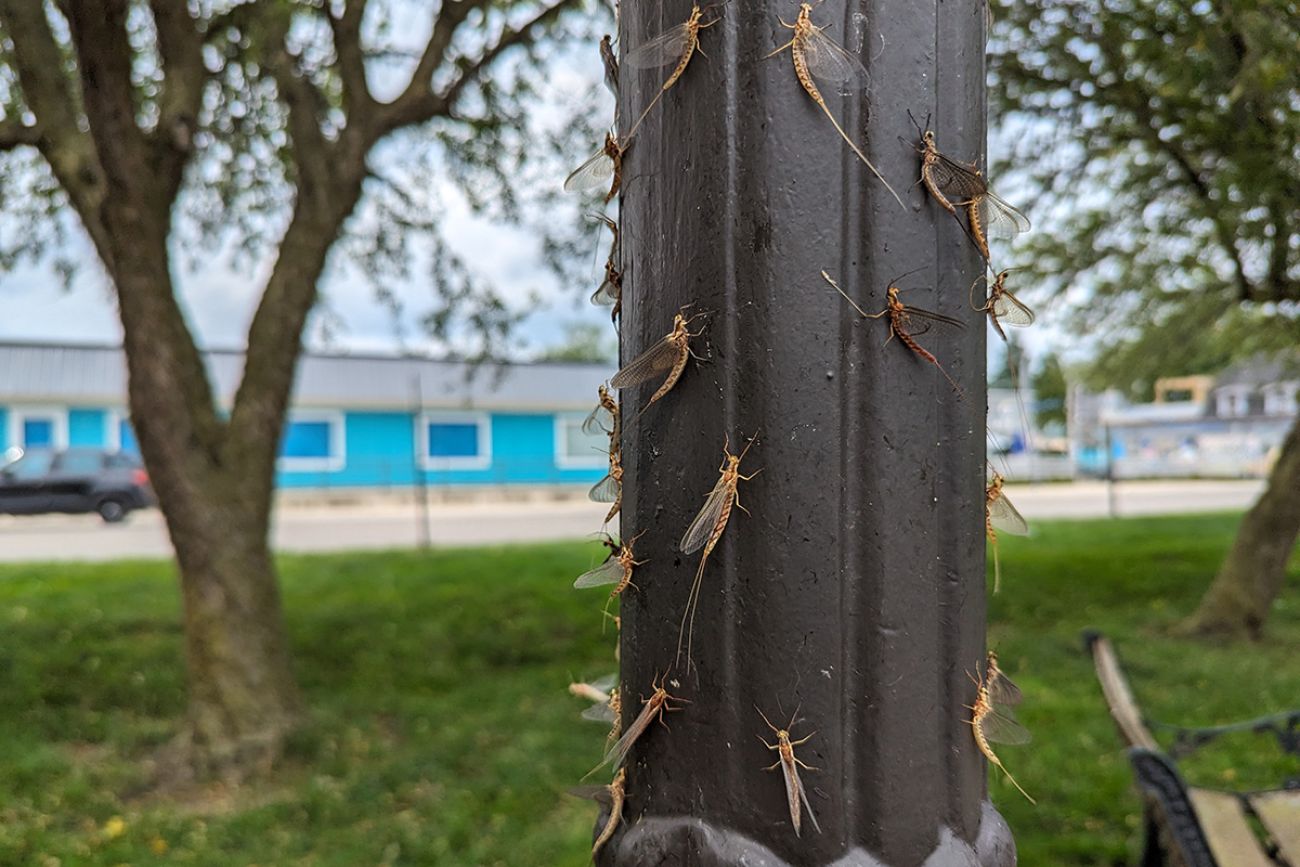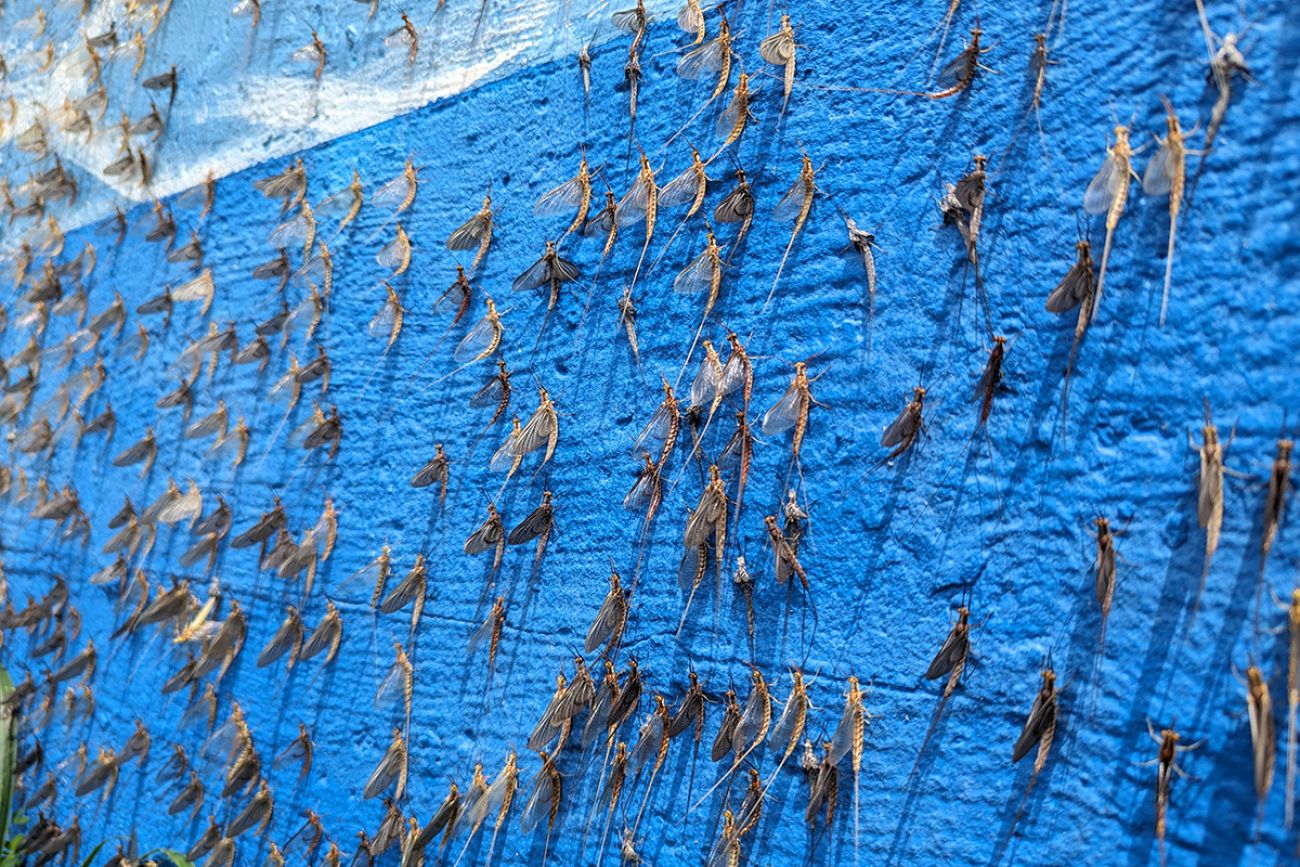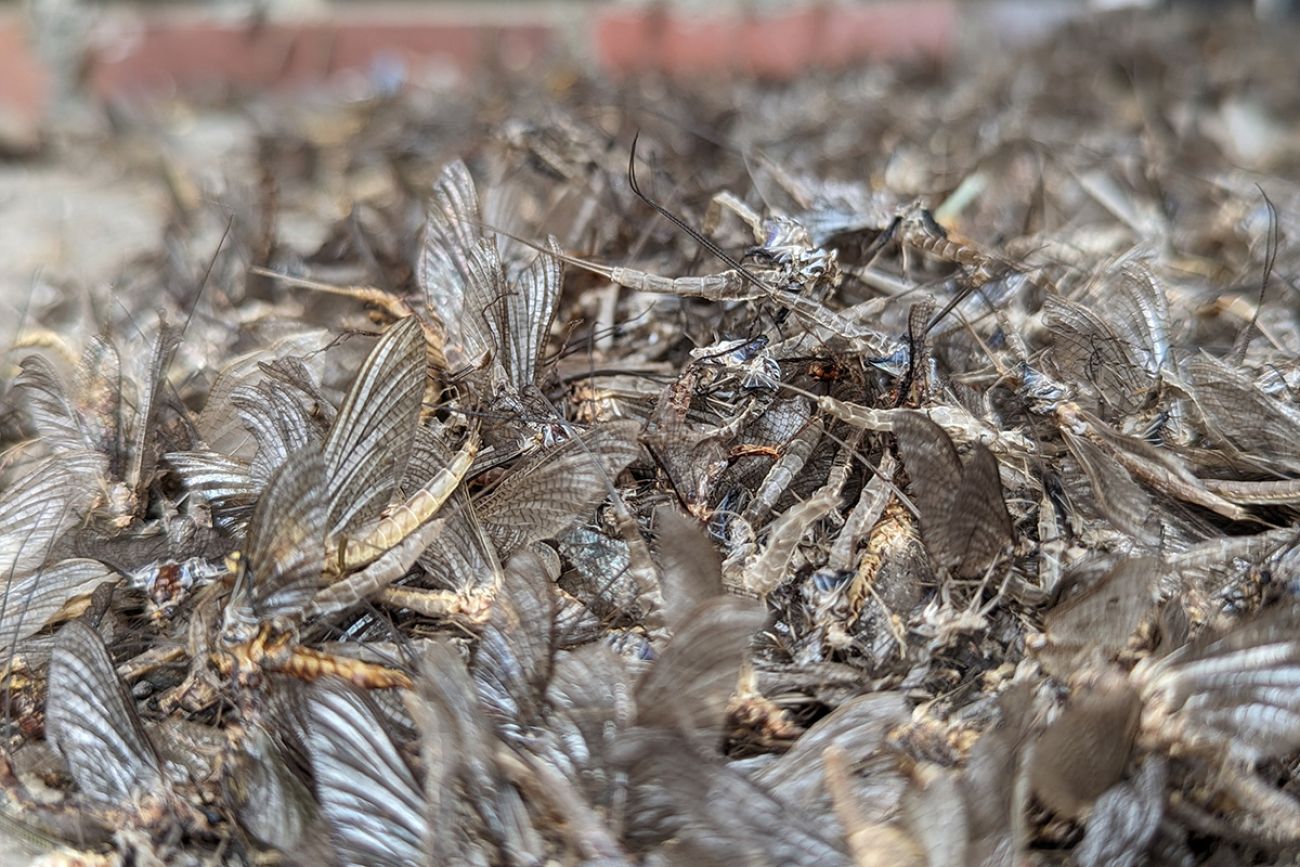Get ready for amorous mayflies, Michigan, and the smelly crunch of love

- Residents near lakeside communities may start to see swarms of mayflies, especially under bright lights
- The insects spend about two days out of the water as adults solely to mate. They don’t bite, or sting and are harmless to humans.
- Residents can also expect to see other insects like mosquitoes throughout the summer, which can transmit diseases
Michiganders can expect to see hundreds of thousands of mayflies in the coming weeks as mating season for the insects nears.
There are over 100 species of mayflies in Michigan. Swarms of them converge each year in lakeside communities near Houghton, Burke or Douglas lakes, where one of the most common species, Hexagenia limbata, or the giant mayfly, can be found.

Mayflies are also a common annual sight in communities in southern Michigan along western Lake Erie and Lake St. Clair. They’ve already emerged in Monroe County, where a Bridge reporter spotted swarms of the insects in Luna Pier Wednesday.
Also called “fish flies,” giant mayflies can arrive as late as July in the Great Lakes basin.
Uh, what exactly is a mayfly?
Adult mayflies are similar in appearance to dragonflies. These aquatic insects tend to have long thin abdomens which can either be gray, yellow or brown. They’re typically a quarter inch to just over an inch long. with transparent wings, long tail filaments and short antennae.
Mayflies spend most of their life in water as larvae. They take a year or two to hatch, and they only live for about a day or so once they emerge to the surface of the water as adults.
Related:
- Spring has already sprung for mosquitoes in Michigan
- Birders flock to Lansing for urgent plea: Help before it’s too late
- Swim at your own risk: High E. coli count closes nine Michigan beaches
“It kind of has a broad range of waters that it can live in and so we find it in a lot of areas,” said aquatic biologist Ann Miller. “The mayfly, when it's living in a lake, only has a one-year lifecycle … but in rivers, because the temperature is colder, it actually takes it two years to develop.”

So the mayflies have surfaced. Now what?
Once adult mayflies emerge from the water, they spend the rest of their lives mating. Once they’ve mated, the female lays a number of eggs on the water's surface and the cycle continues. A female can lay up to 4,000 eggs.
“(Mayflies) do not have any mouthparts, they don't have any digestive system as an adult and … all of the energy that they have in their bodies has to sustain them,” Miller said.
“So in that time, since they're not eating, all their purpose as an adult is just to find the opposite sex and mate,”she said.

If they live on the water, what draws them onto land?
In a word: Light. Swarms of them congregate around gas stations, grocery stores, parking lots, ATMs or anywhere with lights.
Just across the border from Michigan, FirstEnergy Corp.’s Ohio Edison said this week that it is proactively turning off street lights along several roads in the Lake Erie communities of Port Clinton, Marblehead and Erie Township.
"Mayflies create a safety issue because their carcasses contain an oily substance that makes the surfaces they coat very slick, especially when it rains,” FirstEnergy Corp. external affairs consultant Nick Katsaros said in a press statement. “By turning off the streetlights near the lake over the next few months, we can help discourage thousands, even millions, of mayflies from congregating near them."
Because they die soon after mating, groups of dead mayflies can be found in piles stacked on top of each other. They stink like dead fish and crunch when they’re stepped on.

Are they dangerous?
While the insect can be a nuisance when spotted, or smelled, they don’t sting or bite and are completely harmless to humans.
What other flying insects should we be on the lookout for?
Mayflies aren’t the only insects buzzing around during this time of year. Similar insects like stoneflies and caddisflies emerge in early spring. Neither insect has chewing mouthparts and only live to mate, having a lifespan of just a few weeks or less.
But one insect that most people are familiar with is the mosquito, which can bite humans, causing an itchy rash. Mosquitoes can be active from March to November but are most active during the summer months.
Not only do mosquitoes bite but they can also carry diseases like Jamestown Canyon virus, Eastern Equine Encephalitis (EEE) and West Nile Virus.
A pool of mosquitoes in Saginaw County tested positive for Jamestown Canyon virus in May, the Michigan Department of Health and Human Services confirmed. This was the first pool of infected mosquitoes that were tested this year.
“It only takes one bite from an infected mosquito to cause a severe illness,” said Dr. Natasha Bagdasarian, chief medical executive in a press statement. “We urge Michiganders to take precautions such as using an EPA-registered insect repellent when outdoors, avoiding areas where mosquitoes are present if possible and wearing clothing to cover arms and legs to prevent bites.”
The MDHHS suggests residents protect themselves from mosquito-borne diseases:
- Use insect repellents that contain the active ingredient DEET or other EPA-approved products to exposed skin or clothing.
- Wear light-colored, long-sleeved shirts and long pants when outdoors.
- Keep screens on windows and doors to help keep mosquitoes outside.
- Empty water from mosquito breeding sites around the home, such as buckets, unused kiddie pools, old tires and other water-holding containers where mosquitoes can lay eggs
Michigan Environment Watch
Michigan Environment Watch examines how public policy, industry, and other factors interact with the state’s trove of natural resources.
- See full coverage
- Subscribe
- Share tips and questions with Bridge environment reporter Kelly House
Michigan Environment Watch is made possible by generous financial support from:
Our generous Environment Watch underwriters encourage Bridge Michigan readers to also support civic journalism by becoming Bridge members. Please consider joining today.
See what new members are saying about why they donated to Bridge Michigan:
- “In order for this information to be accurate and unbiased it must be underwritten by its readers, not by special interests.” - Larry S.
- “Not many other media sources report on the topics Bridge does.” - Susan B.
- “Your journalism is outstanding and rare these days.” - Mark S.
If you want to ensure the future of nonpartisan, nonprofit Michigan journalism, please become a member today. You, too, will be asked why you donated and maybe we'll feature your quote next time!






